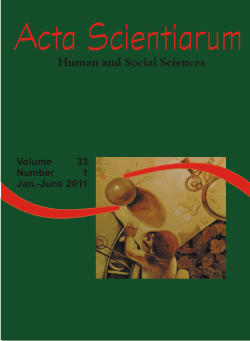<b>Strategies for institutionalizing State Public Universities from Paraná State</b> - doi: 10.4025/actascihumansoc.v33i1.9892
Keywords:
institutionalization of the strategy, process of institutionalization, university
Abstract
Social institutions, especially universities, are appropriate mechanism for the retention, development and dissemination of science, culture and technology in the society. Define and understand the process of institutionalization of universities and their change is a relevant subject. The present study aimed to identify, study and present, - from the perception of key informants - the strategies used in the institutionalization of public universities in Paraná State. Thus, we adopted the subjective conception of the environment, based on contributions from Institutional Theory, Strategy and social actors. Regarding the methods, the research was characterized as qualitative, descriptive and sectional with longitudinal perspective, developed through a case study. Survey data were gathered in primary and secondary way. The analysis of interviews and their results indicate that: (a) possibility of adhesion between the strategies used and their achievement in the form of institutionalization of public universities from Paraná State during the period when the key informant was the head of the institution, (b) adhesion between action and results when faced with the conceptual approach used in the context of administrative sciences and in this, particularly in the area of study strategies.Downloads
Download data is not yet available.
Published
2011-02-24
How to Cite
Tatto, L. (2011). <b>Strategies for institutionalizing State Public Universities from Paraná State</b> - doi: 10.4025/actascihumansoc.v33i1.9892. Acta Scientiarum. Human and Social Sciences, 33(1), 1-11. https://doi.org/10.4025/actascihumansoc.v33i1.9892
Issue
Section
Administration
DECLARATION OF ORIGINALITY AND COPYRIGHTS
I Declare that current article is original and has not been submitted for publication, in part or in whole, to any other national or international journal.
The copyrights belong exclusively to the authors. Published content is licensed under Creative Commons Attribution 4.0 (CC BY 4.0) guidelines, which allows sharing (copy and distribution of the material in any medium or format) and adaptation (remix, transform, and build upon the material) for any purpose, even commercially, under the terms of attribution.
Read this link for further information on how to use CC BY 4.0 properly.























